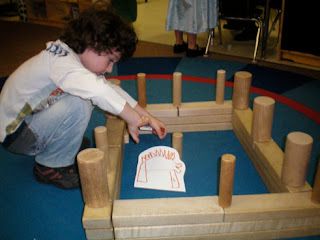The Reggio Approach derives its name from its place of origin, Reggio Emilia, Italy. This gentle and respectful approach to early childhood education, philosophy and practices has evoked worldwide attention. After world war II the women of a nearby village, Villa Cella dedicated themselves to building a school for their children out the ruins of the war. Their intent was to find a better way of life, revering respect for the child and family.
Loris Malguzzi (1920-1994) a young teacher trained in education and psychology joined forces with these villagers and became the father and founder of what we now call, the Reggio Approach. Malaguzzi's ideas on education were strongly influenced great psychologists, philosophers and educators including Bruner, Dewey, Erikson, Piaget and Vygotsky.
Reggio Children was established in 1994 to manage the exchanges between the municipal early childhood services of Reggio and the already established and growing interest of teachers and researchers from all over the world.
The heart.....
At the heart of the approach is the image of the child as competent, full of potential and capable of constructing their own theories. Reggio inspired teachers look to encourage the child's natural social inclinations, love of beauty and drive to interact with their environment. There is joy and playfulness here. There is listening, sharing and wonder here.
At the heart of the approach is the image of the teacher as researcher, collaborator, loving guide and facilitator. The teacher is equally viewed as significant to the child's learning and growth. Her affection and relationship with the child is profound. Teachers remain with their students for three years in Italy. The Reggio approach asks teachers to open new doors. She begins with the child's theories and works to weave unique and creative experiences to facilitate new learning from there. She does this by asking questions, welcoming contradictions that spark discussion, exploration and discovery. She is an observer, co-constructor of knowledge and part of the learning process.
The curriculum.....
Loris Malaguzzi called the many ways children symbolically express their knowledge and intent in sharing that knowledge, The Hundred Languages. These natural languages of the child include drawing, painting, words, writing, music, shadow play, dramatic play, building and sculpting. Children work solving their problems and representing their ideas. Children are encouraged to re-visit their work to modify or add to their intentions as new knowledge is grasped. Teachers, families, and community are each integral parts of the child's learning. Educational content, objectives and practices are discussed and agreed upon. Respecting the rights of child, teacher and parent's role to determine the most meaningful and rich practices, the curriculum emerges rather than is dictated by a preconceived set of themes, concepts and activities. Unlike many traditional curriculum where the product is given the most attention, here the process is what the teacher is most interested in to gain insight to the child's thought patterns and grasp of any given subject area.
Project work.....
Children are encouraged to work on in depth studies. Provocations or promptings evoke an interest for the child. Teachers encourage discussion of what is known already, what they would like to know, carefully listening, asking questions and recording the children's dialogue and ideas. After teachers evaluate and share perceptions, a plan for exploration, discovery, testing and an expression of learning. Project-type involvements last in duration as long as there is interest on the part of both the children and the teacher. In general these projects are done with a small group of children while others are involved in self-selected activities and explorations.
The environment....
Loris Malaguzzi called the environment "the third teacher" and reminds us of the profound role of the physical, emotional, and social environments we provide for the young child. Arrangement of furnishings promote social connections are paramount; spaces are beautiful, engaging and comfortable; materials are accessible, easily managed by the children, aesthetically arranged to spark social, creative and cognitive learning.
Documentation....
Documentation is one of the key elements to the practice. Reggio teachers grow to be skilled observers and listeners. They record anecdotes, take photos and videos of the the children working and interacting with others. She records what the children are doing and how they are using the materials. Documentation and displays of children's work are made visible for children and families on the wall and in the halls of the learning environment and shared with others technologically. Documentation of children's explorations and learning serves as a tool for assessment and analyzes for both child and teacher; provides a history; makes learning visible and is a sign to the child that they are important and what they say, do and create is valued and wonderful!
Articles
Newsweek article 1991 - best preschools in the world
New York Times article - Englewood, NJ School
New York Times article - Madison Avenue Presbyterian Church Day School
Brainy Child article - early childhood brain development
Links
Official Reggio Emilia Site - an educational project
Project Zero - Harvard research group
School Within a School - Washington, D.C.
A Child's Place - Lincroft, NJ
Union Congregational Weekday Nursery School Montclair, NJ
Voyagers' Community School - Farmingdale, NJ
Wonder Tree School - Sacramento CA
Beautiful Blogs







